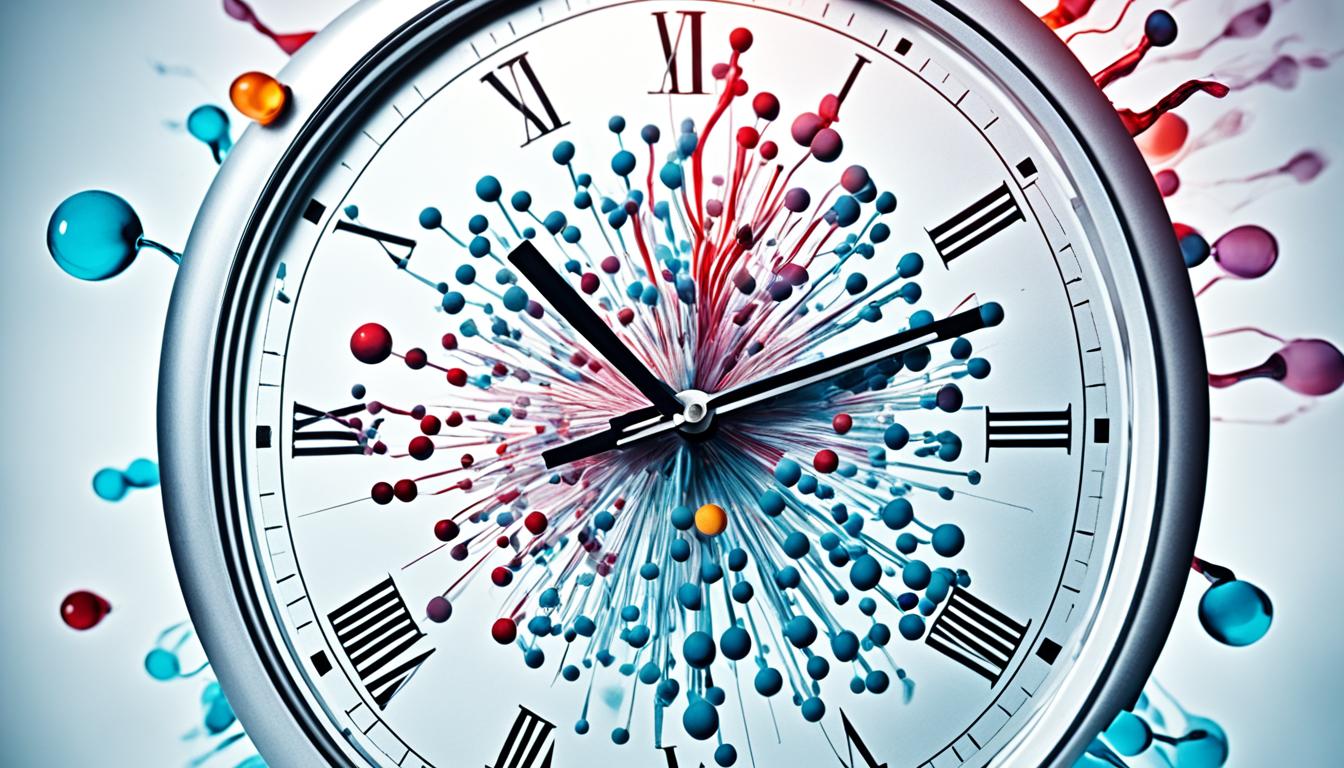In this article, we will address an important question that often arises: How long does it take for alcohol to leave your system? Understanding the timeline for alcohol detoxification is essential for making informed decisions and maintaining a healthy lifestyle.
Alcohol metabolism rate and alcohol elimination time play significant roles in determining how quickly alcohol is cleared from your system. By exploring these factors, we can gain valuable insights into the detoxification process and its duration.
Throughout this article, we will also examine the influence of various factors on alcohol detoxification. Factors such as body weight, liver health, and hydration levels can affect the speed at which alcohol is eliminated from the body.
Additionally, we will discuss the relationship between alcohol clearance time and blood alcohol concentration. Understanding this connection provides a deeper understanding of how our bodies process alcohol.
Alcohol half-life and metabolism rate are critical aspects of alcohol detoxification. We will explore how these factors impact the rate at which alcohol is eliminated from the body.
Furthermore, it’s important to be aware of alcohol withdrawal symptoms that individuals may experience during the detoxification process. By recognizing these symptoms and seeking professional help when needed, individuals can navigate the detoxification period more effectively.
To provide a comprehensive understanding, we will outline a timeline for alcohol detoxification based on different levels of alcohol consumption. This timeline will serve as a helpful resource for individuals who want to better grasp the duration of the detoxification process.
In conclusion, understanding how long it takes for alcohol to leave your system is crucial for responsible alcohol consumption and maintaining overall health. By considering factors such as alcohol metabolism rate, clearance time, and individual differences, individuals can make informed choices and prioritize their well-being.
Alcohol Metabolism and Processing in the Body
Understanding how alcohol is metabolized and processed in the body can provide insights into its effects and elimination. Alcohol processing in the body involves the action of various enzymes that break down alcohol into byproducts that can be eliminated from the system.
One of the key enzymes involved in alcohol metabolism is alcohol dehydrogenase (ADH). ADH plays a vital role in the initial breakdown of alcohol by converting it into acetaldehyde, a toxic substance. Another enzyme called acetaldehyde dehydrogenase (ALDH) further metabolizes acetaldehyde into acetic acid, which can eventually be converted into carbon dioxide and water.
Alcohol metabolism enzymes, such as ADH and ALDH, are primarily found in the liver. When alcohol enters the body, these enzymes are activated to begin the process of alcohol metabolism. The rate at which alcohol is metabolized can vary from person to person, depending on factors such as genetics, liver health, and enzyme activity.
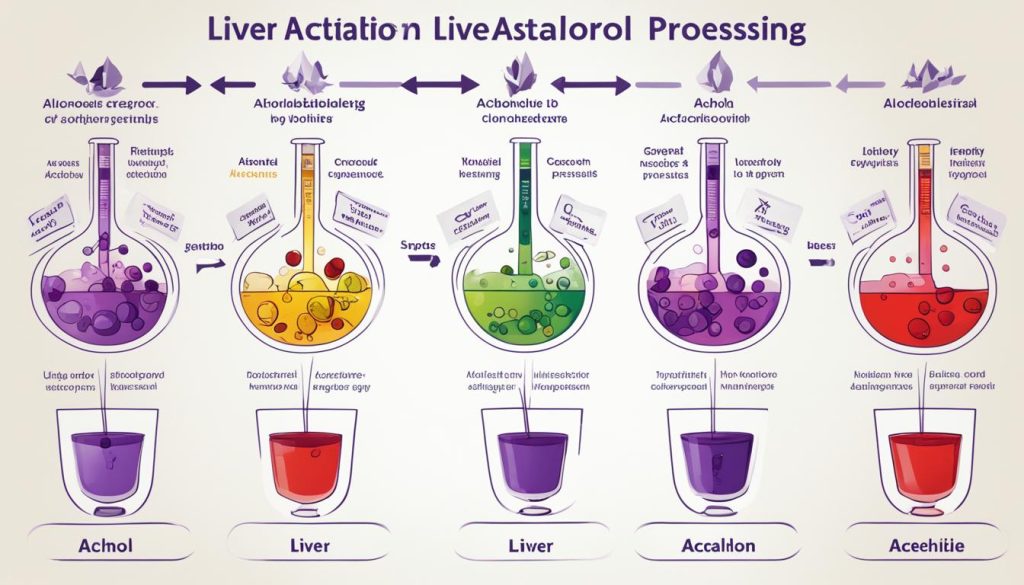
“The role of alcohol metabolism enzymes in breaking down alcohol should not be underestimated. They play a crucial role in converting alcohol into byproducts that can be eliminated from the body.”
The efficiency of alcohol metabolism can affect how long alcohol stays in the body. For most people, the average rate of alcohol metabolism is approximately 0.015 grams per deciliter (g/dL) per hour. However, this rate can vary based on individual factors. It is important to note that alcohol metabolism is a complex process influenced by numerous factors, and its effects can differ from person to person.
The Role of Genetics in Alcohol Metabolism
Genetics can significantly impact alcohol metabolism. Variations in genes that code for alcohol metabolism enzymes, such as ADH and ALDH, can affect the efficiency of alcohol processing in the body. Some individuals may have genetic variations that result in faster or slower alcohol metabolism rates. These genetic differences can contribute to variations in alcohol tolerance and the rate at which alcohol is eliminated from the body.
Alcohol Metabolism and Blood Alcohol Concentration
The process of alcohol metabolism has a direct impact on blood alcohol concentration (BAC). As alcohol is metabolized in the body, the concentration of alcohol in the bloodstream gradually decreases. The rate at which this occurs depends on the individual’s alcohol metabolism rate and the amount of alcohol consumed.
In general, alcohol metabolism follows a predictable pattern. On average, it takes about one hour for the body to metabolize one standard drink, which is equivalent to approximately 14 grams of pure alcohol. However, this time frame can vary based on factors such as body weight, hydration levels, and the presence of food in the stomach.
| Number of Standard Drinks | Approximate Metabolism Time |
|---|---|
| 1 | Approximately 1 hour |
| 2 | Approximately 2 hours |
| 3 | Approximately 3 hours |
| 4 | Approximately 4 hours |
It is important to note that while alcohol metabolism can help reduce blood alcohol concentration, it does not speed up the elimination of alcohol from the body. Only time can effectively eliminate alcohol from the system.
Factors Affecting Alcohol Detoxification
Alcohol detoxification is influenced by various factors that can impact the speed at which alcohol is cleared from the body. Understanding these factors is crucial for individuals seeking to manage their alcohol consumption responsibly. Some key factors that affect alcohol detoxification include:
1. Body Weight
The body weight of an individual plays a significant role in alcohol detoxification. Generally, those with a higher body weight have a higher water content, which can dilute the alcohol and slow down its metabolism and elimination from the body.
2. Liver Health
The liver is responsible for metabolizing alcohol in the body. If the liver is damaged or not functioning optimally, alcohol clearance can be impaired. Conditions such as fatty liver disease or liver cirrhosis can significantly impact the detoxification process.
3. Hydration Levels
Hydration levels can affect alcohol detoxification as well. When the body is well-hydrated, it can aid in the breakdown and elimination of alcohol through urine. On the other hand, dehydration can impair the body’s ability to clear alcohol effectively.
4. Enzyme Variants
Enzyme variants, such as the presence of specific alcohol-metabolizing enzymes like ADH and ALDH, can also influence alcohol detoxification. Different individuals may have differing levels of these enzymes, which can impact how quickly alcohol is broken down and eliminated from the body.
5. Genetics
Genetics can play a role in alcohol detoxification. Certain genetic variations can affect the body’s ability to metabolize alcohol efficiently. For example, individuals with a genetic variant that results in a deficiency of the ALDH enzyme may experience unpleasant symptoms, such as facial flushing and nausea, when consuming alcohol.
By considering these factors, individuals can gain a better understanding of how their bodies metabolize and eliminate alcohol. It is important to remember that every person’s alcohol detoxification process can be unique, and seeking professional guidance is recommended, especially for individuals with underlying health conditions or concerns.
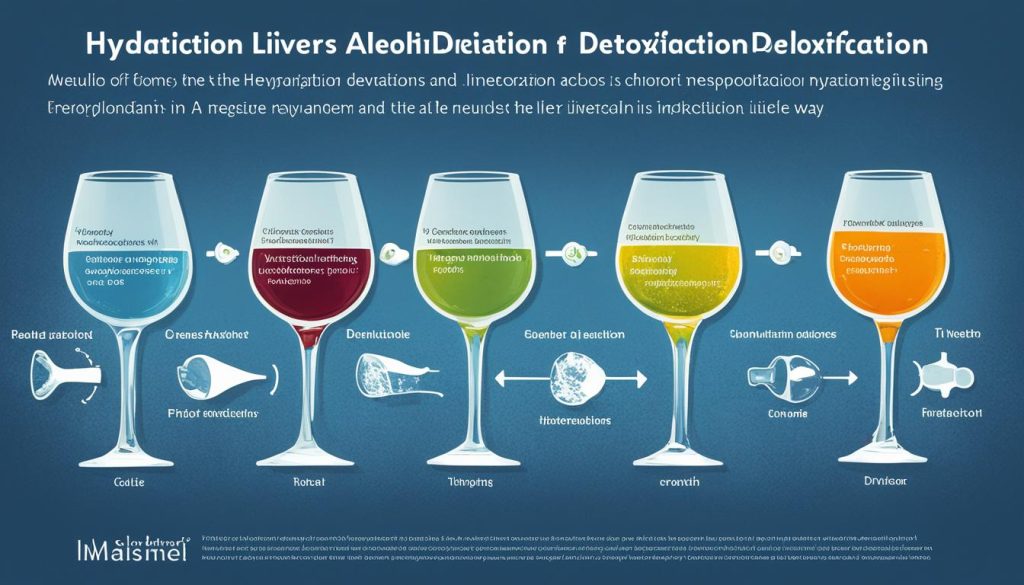
Understanding the factors that influence alcohol detoxification can empower individuals to make informed choices regarding their alcohol consumption. By considering body weight, liver health, hydration levels, enzyme variants, and genetic factors, individuals can better understand how their bodies process and clear alcohol. It is essential to prioritize health and well-being and seek professional guidance if needed during the alcohol detoxification process.
Alcohol Clearance Time and Blood Alcohol Concentration
When it comes to alcohol consumption, understanding the relationship between alcohol clearance time and blood alcohol concentration is crucial. The rate at which alcohol is cleared from the body affects how long it takes for the individual to reach a sober state.
The body eliminates alcohol through a process called alcohol clearance. This process involves metabolizing alcohol and eliminating it from the bloodstream. The speed at which alcohol is cleared from the body varies depending on several factors, including the individual’s metabolism, liver health, hydration levels, and the amount of alcohol consumed.
One of the key measures used to assess alcohol clearance is blood alcohol concentration (BAC). BAC refers to the amount of alcohol present in the bloodstream and is typically measured as a percentage. As the body clears alcohol, the BAC decreases until it reaches zero, indicating that the person is sober.
It is important to note that alcohol clearance time can vary widely among individuals. Factors such as body weight, liver function, and overall health can influence the rate at which alcohol is metabolized and eliminated from the body. Additionally, the type of alcoholic beverage consumed and the presence of food in the stomach can also affect alcohol clearance time.
To visualize the relationship between alcohol clearance time and blood alcohol concentration, refer to the table below.
| Blood Alcohol Concentration (BAC) | Alcohol Clearance Time |
|---|---|
| 0.08% (Legal Limit) | 2-3 hours |
| 0.02% | 1-2 hours |
| 0.00% | Up to 1 hour |
Note: The values provided are approximate and can vary depending on individual factors and circumstances.
It is important to realize that attempting to speed up alcohol clearance through methods such as drinking coffee or taking cold showers is ineffective. Only time can allow the body to process and eliminate alcohol.
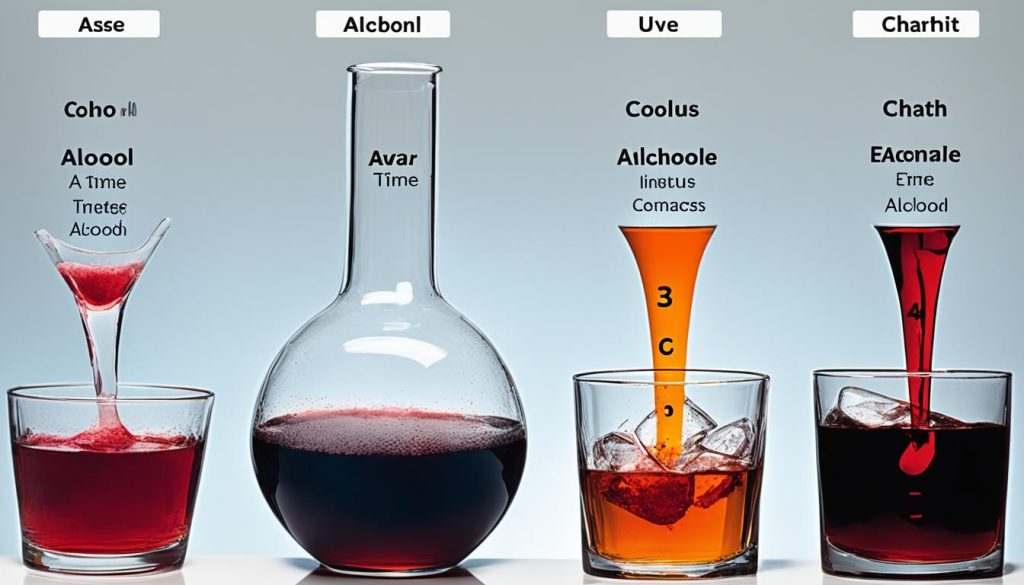
Remember, alcohol clearance takes time, and it is essential to prioritize safety and responsible drinking habits. If you are planning on drinking, make sure to allow ample time for the alcohol to clear your system before driving or engaging in any activities that require alertness and coordination.
Alcohol Half-Life and Metabolism Rate
Understanding the concepts of alcohol half-life and metabolism rate is crucial in determining how long it takes for alcohol to be eliminated from the body. Let’s explore these factors in detail.
Alcohol half-life refers to the time it takes for the concentration of alcohol in the bloodstream to decrease by half. The half-life can vary depending on various factors, including individual differences and alcohol metabolism rate.
Alcohol metabolism rate refers to how quickly the body breaks down alcohol into byproducts that can be eliminated. This process primarily occurs in the liver, where enzymes metabolize alcohol. One of the main enzymes involved is alcohol dehydrogenase (ADH), which converts alcohol into acetaldehyde.
The rate at which alcohol is metabolized can vary among individuals and can be influenced by factors such as genetics, age, liver health, and the presence of other substances in the body. Additionally, the metabolism rate can be affected by external factors like the amount of alcohol consumed and the presence of food in the stomach.
“The rate at which alcohol is metabolized can vary among individuals and can be influenced by factors such as genetics, age, liver health, and the presence of other substances in the body.”
To better understand the relationship between alcohol half-life and metabolism rate, let’s take a look at this illustrative table:
| Metabolism Rate | Alcohol Half-Life |
|---|---|
| Fast | 2-3 hours |
| Average | 3-5 hours |
| Slow | 5+ hours |
The table demonstrates how individuals with a faster metabolism rate tend to eliminate alcohol more rapidly, resulting in a shorter half-life. Conversely, individuals with a slower metabolism rate may take longer to eliminate alcohol, leading to a longer half-life. It’s important to note that these are estimated time ranges and can vary based on individual factors.
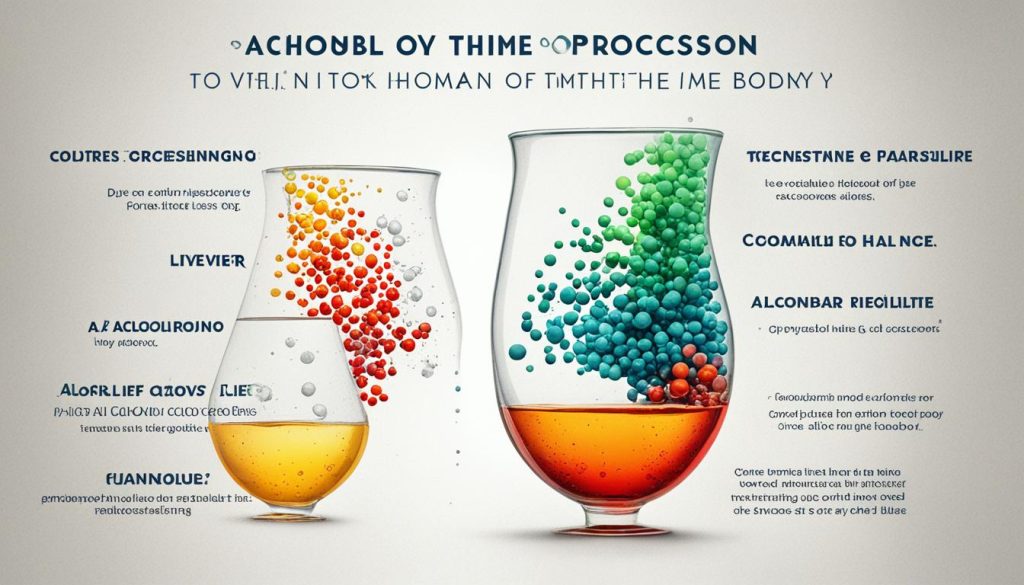
Having an understanding of alcohol half-life and metabolism rate can help individuals make informed decisions about alcohol consumption and gauge how long it may take for alcohol to leave their system. However, it’s important to remember that alcohol detoxification is a complex process influenced by various factors, and professional medical advice should be sought for specific concerns or questions.
Alcohol Withdrawal Symptoms
When the body goes through the process of eliminating alcohol, it may experience withdrawal symptoms. These symptoms can vary in severity and duration, depending on factors such as the individual’s alcohol consumption patterns and overall health. It is important to be aware of these symptoms and seek medical help during alcohol detoxification.
1. Common Alcohol Withdrawal Symptoms
Some common alcohol withdrawal symptoms include:
- Tremors or shaking
- Anxiety
- Nausea and vomiting
- Sweating
- Insomnia
- Irritability and mood swings
- Headaches
- Depression
- Increased heart rate
These symptoms usually begin within a few hours to a day after the last drink and can persist for several days. In some cases, more severe symptoms such as hallucinations, seizures, and delirium tremens (DTs) can occur. DTs are a medical emergency and require immediate medical attention.
It’s important to note that everyone may experience alcohol withdrawal differently, and the severity of symptoms can vary. Seeking medical help during this time is crucial to ensure proper support and care throughout the detoxification process.
“Alcohol withdrawal symptoms can range from mild to severe and can impact individuals differently. It’s important to prioritize your health and seek medical help if you experience any concerning symptoms during alcohol detoxification.”
2. When Do Alcohol Withdrawal Symptoms Occur?
The timing of alcohol withdrawal symptoms can vary depending on several factors, including the individual’s alcohol consumption patterns and overall health. In general, mild symptoms may begin as early as six hours after the last drink and peak within 24-48 hours. More severe symptoms, such as delirium tremens, usually occur within 48-72 hours after the last drink.
Being aware of the potential timing of these symptoms can help individuals and their support systems better understand and manage alcohol withdrawal.
Remember, if you or someone you know is experiencing alcohol withdrawal symptoms, it is essential to seek medical help. Healthcare professionals can provide guidance, support, and appropriate interventions to ensure a safe and successful alcohol detoxification process.
Timeline for Alcohol Detoxification
Understanding the timeline for alcohol detoxification is crucial for individuals who want to know how long it takes for alcohol to leave their system. The process of eliminating alcohol from the body involves several stages, each with its own estimated time frame. These stages depend on the individual’s alcohol consumption level and can vary from person to person. Below, we provide a comprehensive overview of the stages of alcohol elimination and their corresponding time frames.
Stage 1: Absorption
When alcohol is consumed, it is rapidly absorbed into the bloodstream through the stomach and small intestine. This absorption process on average takes around 20 minutes to 2 hours, depending on various factors such as the type of alcoholic beverage, tolerance level, and the presence of food in the stomach. During this stage, alcohol reaches peak blood alcohol concentration (BAC) levels, leading to the onset of its effects.
Stage 2: Distribution
After being absorbed into the bloodstream, alcohol distributes itself throughout the body, affecting various organs and tissues. The rate of distribution is influenced by factors such as body composition, hydration levels, and genetic factors. This stage typically lasts for a few hours, during which alcohol continues to exert its effects on the body.
Stage 3: Metabolism
The liver plays a crucial role in alcohol metabolism, breaking it down into byproducts that can be eliminated from the body. The primary enzyme responsible for alcohol metabolism is alcohol dehydrogenase (ADH). The rate of metabolism varies among individuals but generally ranges from 0.015 to 0.025 BAC per hour. This means that it takes about an hour and a half to two hours for the body to eliminate the alcohol from one standard drink.
Stage 4: Elimination
The final stage of alcohol detoxification involves the elimination of alcohol and its byproducts from the body. This occurs primarily through urine, sweat, and breath. It typically takes an average of one hour to eliminate the alcohol content of one standard drink from the body.
It is important to note that the estimated time frames provided are generalizations and can vary based on factors such as age, liver health, metabolism rate, and overall health. Additionally, consuming large amounts of alcohol or drinking heavily over an extended period can significantly extend the detoxification process.
“The rate at which alcohol is eliminated from the body is relatively constant, regardless of factors such as gender or height. However, individual differences in metabolism and other factors can influence the detoxification process.”
It is essential to remember that alcohol detoxification is a gradual process, and the body needs sufficient time to fully eliminate alcohol and its effects. During this time, it is crucial to prioritize rest, hydration, and engage in healthy habits to support the body’s detoxification process.
| Number of Standard Drinks Consumed | Approximate Time for Alcohol to Leave the System |
|---|---|
| 1 | 1.5 – 2 hours |
| 2 | 3 – 4 hours |
| 3 | 4.5 – 6 hours |
| 4 | 6 – 8 hours |
| 5 | 7.5 – 10 hours |
It is important to allow ample time for alcohol to fully leave the system before engaging in activities that require focus, coordination, or driving. Always prioritize responsible alcohol consumption and consider alternative transportation options if needed.
Conclusion
In conclusion, understanding how long it takes for alcohol to leave your system is crucial for maintaining a healthy lifestyle and making responsible choices. The detoxification process is influenced by factors such as alcohol metabolism rate, clearance time, and individual differences.
During alcohol detoxification, it is important to be aware of the potential alcohol withdrawal symptoms that may occur. These symptoms can range from mild to severe, and seeking professional help is essential to ensure a safe and comfortable detoxification period.
Remember, when consuming alcohol, always prioritize your health and well-being. Drink responsibly and be mindful of your own limits. If you have concerns or questions about alcohol detoxification, do not hesitate to reach out to healthcare professionals who can provide guidance and support.
FAQ
1. How long does it take for alcohol to leave your system?
The timeline for alcohol detoxification can vary depending on several factors. On average, it takes about one hour for the body to metabolize one standard drink. However, it can take up to five hours or longer for alcohol to completely leave your system. Keep in mind that individual factors such as body weight, metabolism rate, and liver health can also impact the detoxification process.
2. How is alcohol metabolized and processed in the body?
Alcohol is primarily metabolized in the liver through the action of enzymes such as alcohol dehydrogenase and acetaldehyde dehydrogenase. These enzymes break down alcohol into byproducts that can be eliminated from the body. The metabolization process occurs at a relatively constant rate, regardless of the amount of alcohol consumed.
3. What factors can affect alcohol detoxification?
Several factors can influence the speed at which alcohol is cleared from the body. Body weight plays a role, as individuals with a higher body weight may metabolize alcohol more quickly. Liver health is another important factor, as a healthy liver can process alcohol more efficiently. Additionally, hydration levels can affect alcohol detoxification, as being properly hydrated can support liver function and facilitate alcohol elimination.
4. How does alcohol clearance time relate to blood alcohol concentration?
Alcohol clearance time refers to the duration it takes for alcohol to be completely eliminated from the bloodstream. Blood alcohol concentration (BAC) is a measure of the amount of alcohol in the bloodstream at a given time. As alcohol is metabolized and eliminated, the BAC decreases. The clearance time can vary depending on factors such as the amount of alcohol consumed and individual metabolism rates.
5. What is alcohol half-life and how does it affect alcohol elimination?
Alcohol half-life refers to the amount of time it takes for half of the alcohol consumed to be eliminated from the body. The average alcohol half-life is about 4-5 hours, but it can vary depending on individual factors. The half-life affects the overall metabolism rate, as it determines how quickly alcohol is processed and eliminated from the body.

